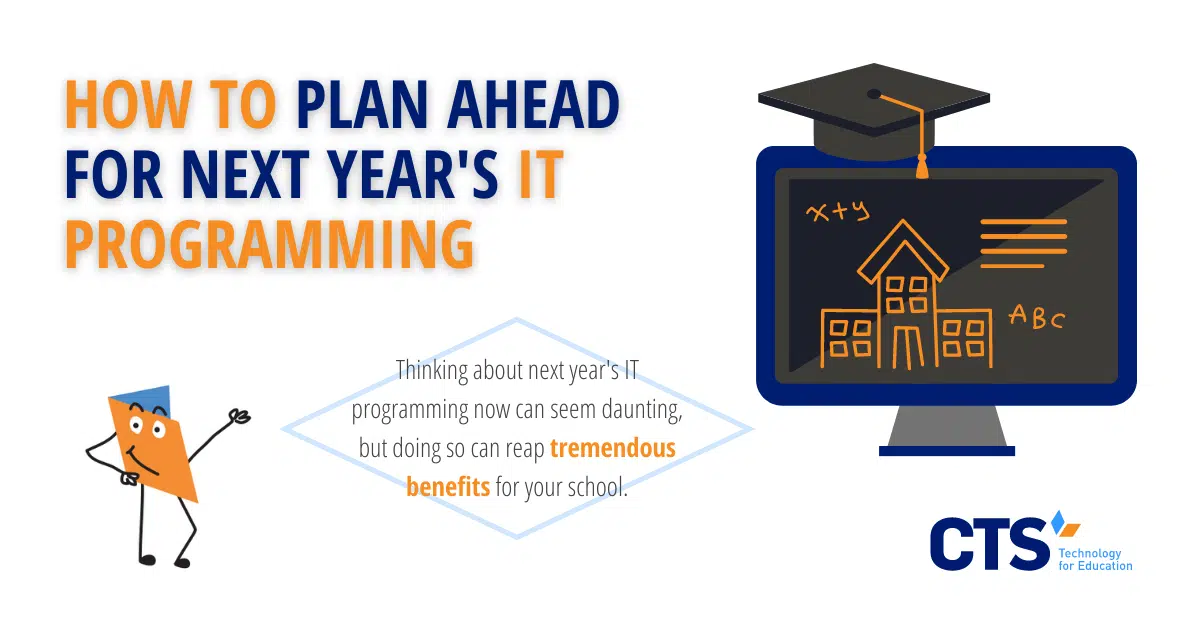Start planning next year’s IT programming now.
With state testing, parent-teacher conferences, and end-of-year close-out on the horizon, it can be difficult for school leaders to think ahead to the next week or month, let alone the next school year. With so many competing priorities on their plates, school leaders and their teachers tend to focus on keeping the trains running each day rather than on forward planning that could add value to their school’s programming.
However, taking the time to think through next school year’s IT programming can reap tremendous benefits for students and teachers. With a proper plan in place, school leaders can open their doors next year with a cohesive vision of their school’s IT programming and a concrete plan to execute it throughout the academic year.
Planning for a successful school IT program begins with an effective school close-out, one that leverages the end of the school year to inventory and track all school-issued devices. School leaders can also lower their IT costs by taking advantage of federal E-rate funding, allowing them to accomplish specific IT goals that might otherwise be out of reach. Finally, whether to hire additional personnel, third-party vendor sourcing and professional development for teachers all have a role to play in schools’ planning process.
By considering these and other IT-related considerations, school leaders can set their schools up for success and provide their students and teachers with world-class technology programming.
During close-out, create a system to inventory and track all school-issued devices.
First and foremost, school leaders need to get a handle on their existing technology inventory. Doing so begins with an effective school close-out plan. Before teachers leave the building for the summer, school leaders should ensure they turn in all school-issued devices (both teacher- and student-facing) so that the school’s IT team can tag and inventory each piece of hardware. From there, school leaders can determine with precision how much new technology they’ll need to purchase for the following year and which pieces of hardware can be re-purposed or repaired rather than replaced.
Leverage E-rate funding to lower your school’s IT costs.
Once the school has decided what technology it needs to purchase, school leaders should take advantage of the federal E-rate program, which reimburses schools for select IT-related purchases. Wiring, critical IT infrastructure, and other “back-end” technology can be pricey. By thinking ahead and forecasting—even before close-out—what technology the school might need for the following year, school leaders can save thousands of dollars that can then be diverted to other instructional priorities.
Next year’s IT programming might require additional personnel.
As next year’s IT programming needs become clearer, school leaders may also decide that they need to hire additional in-house IT team members or expand their relationship with their current managed IT, provider. Doing so can come with significant costs, particularly if the school is planning a dramatic expansion of its technology programming. If this is the case, school leaders should think long and hard about whether using an in-house team makes sense for their school, given the scale of its technology programming. Often, schools can save significant amounts of money by fulling outsourcing their IT management to a third-party provider.
Thinking about outsourcing a specific IT project? Begin engaging potential vendors.
School leaders should also begin sourcing and meeting with potential vendors for one-off, complex IT projects that will require support beyond the school’s in-house team. With students and teachers out of the building during the summer, June, July, and August are prime opportunities for schools to accomplish otherwise disruptive IT projects. Rather than cordoning off a section of the school for weeks at a time or planning for temporary wireless internet outages, school leaders can leverage the summer months to accomplish IT projects that add significant value to school programming.
Finally, think through how you’ll train teachers to execute next year’s IT programming.
Of course, the school’s vision for IT programming is of little use if teachers aren’t on board. To ensure the successful implementation of its IT programming vision, school leadership teams should build in technology-related sessions to their school’ professional development offerings. Taking the time to train teachers on the school’s new technology can help ensure that the school makes the most of its technology-related investments and highlights the link between its technology program and instruction.
At CTS, we help schools accomplish their unique missions.
Our team has worked with more than 60 schools across the United States to improve the quality of their technology programming. From managed IT services to IT project execution, educational data services, and a host of other offerings, we offer schools the full range of technology support they need to accomplish their instructional goals. Contact us today to learn more about our services and how we can help your school accomplish its unique mission.




